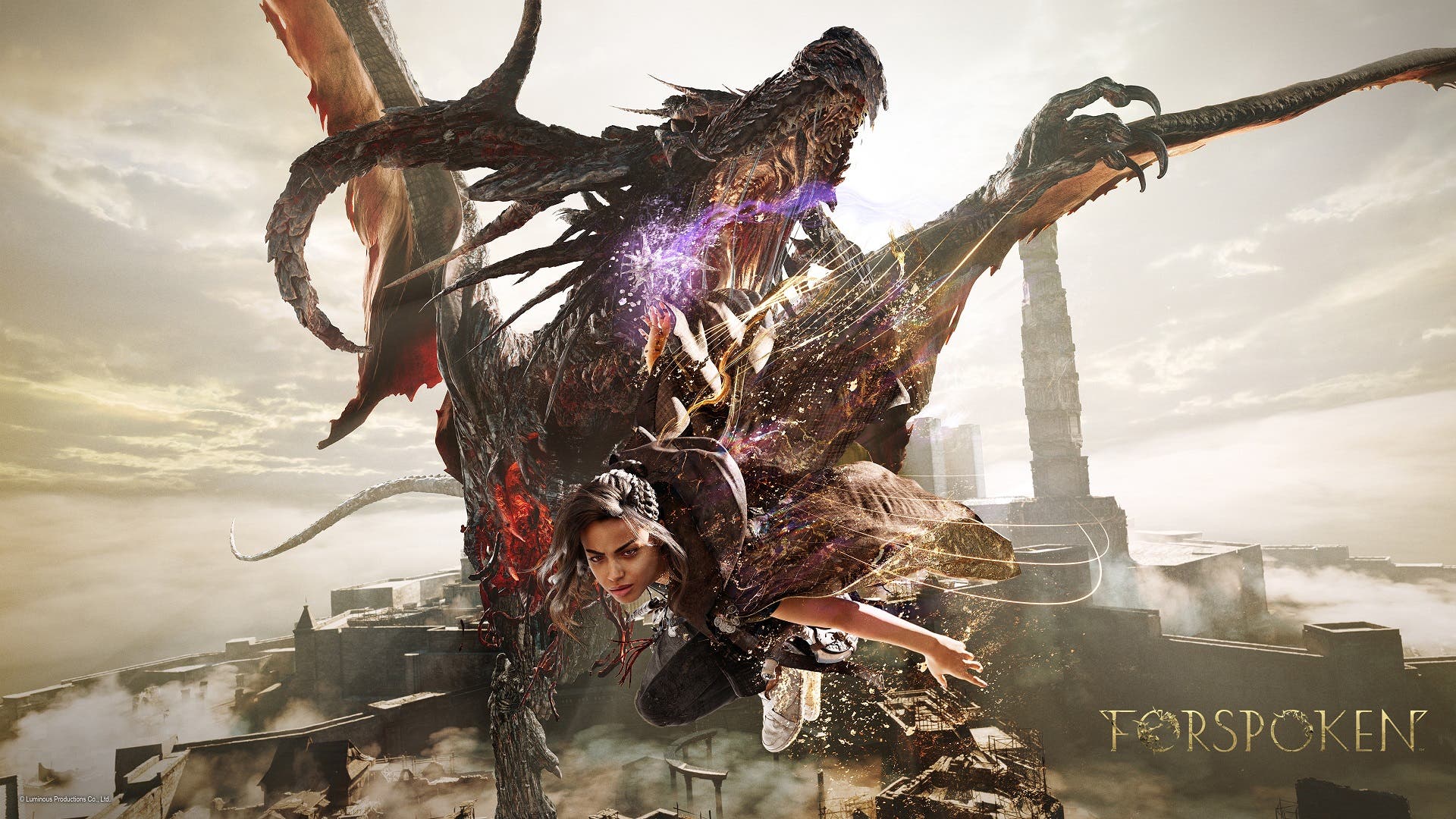I am a gamer that enjoys a good story over all else. Game mechanics are just the icing on the cake, and artistic design is the cherry on top. If a game has an underwhelming narrative and is not engaging, I will drop it like a rock. Mechanics or an art style can not carry a game on its own. That was my firm belief until now. Forspoken is a stunningly beautiful game with amazing color pallets and elegant free-running traversal. I found myself coming back to Forspoken daily to run around the world. But before all the finer details, let’s talk about this game and the insanely basic story.
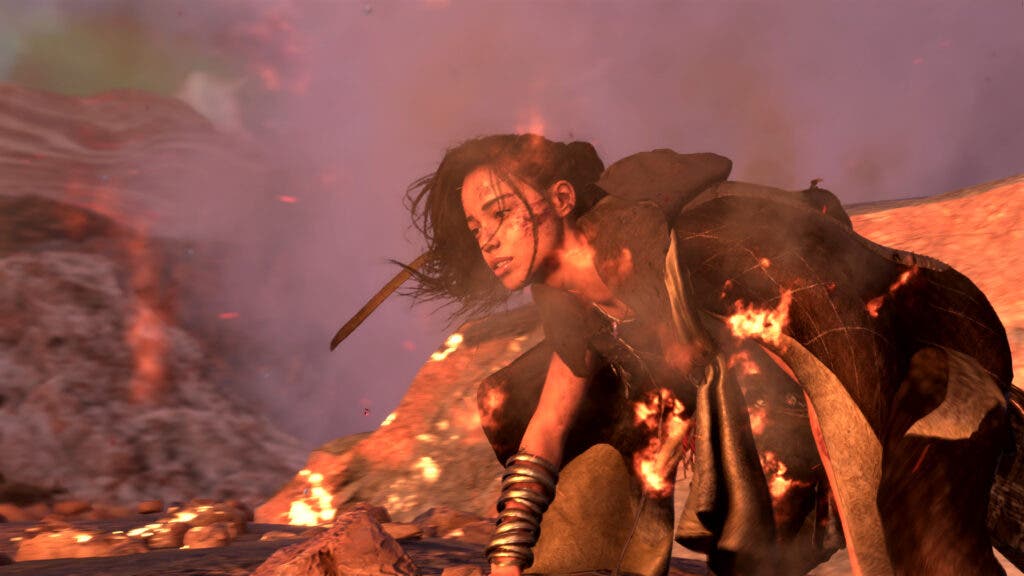
In Forspoken, you play Frey Holland, an orphan in New York who was found in the Holland Tunnel as an infant, hence her name. Frey grew up jumping from sister home to foster home until she had aged out. We pick things up with a 21-year-old Frey, who is constantly in trouble with the law. She stands before a New York City Judge who gives her the obligatory “one last chance to change.” message. From here, it is painfully obvious how this story will pan out. If you have seen any “emotional, learning of one’s self” piece of media in the past 20 years, you’ll see the twist coming from miles away.
Frey is in trouble with a local gang. She must steal a car for them while members of this gang tag along. They “encourage” Frey to re-steal a car already once stolen for the boss. Using the movie trope of surrounding the main character and having the evil but misguided lead member gut-punch the protagonist, we are supposed to feel for Frey as the down-and-out girl who has so much potential; it’s overused and underwhelming. Then, we enjoy the wonderful world of a horribly directed running tutorial. Frey gets away from the dance battle-esque circle and runs for her life through back alleys and along roads. Mind you, these back alleys are not all that hidden as they connect to the same street in less than a few steps. Most are fully visible from the main road, so yeah.
After finally escaping the bad dudes, she walks home to an abandoned building that, amazingly, has power and running water. Because as we all know, this is how cities handle abandoned buildings. Here we learn that Frey has a pet cat and has been saving her money to finally leave New York City to start a new life with her cat. Frey and the kitty are here for one more day, and they can leave this life all behind. Tragically, Frey wakes up to her abandoned building on fire and her kitty nowhere to be seen. Frey decides not to pick up the duffle bag full of money she’s been saving and instead looks for her cat. Walking over the fire that lines her doorway, she finds the cat to realize at that moment money is flammable; she loses it all. She quickly learns that the gang is the cause of the fire with a note left on her window.
Realizing she has nothing left, she decides to drop her cat off with the judge so it will be safe and go galivant around the Holland Tunnel to regain control of her life. She sees a bracer or cuff that may be worth some money. She picks it up and is surprised when the cuff is immediately attached to her forearm. Behind her, a portal opens, and as any of us would do, she decides to walk through. She becomes upset that the portal closes behind her. The cuff speaks and is British. After some banter, we are treated to a beautiful view of this new world of Athia, where the game truly begins.

Athia is a medieval fantasy land with a giant dragon terrorizing the world. You learn about a fog that Frey names the Break, as it breaks anything that comes into contact with it, whether it is buildings, plants, animals, or humans. Curiously, Frey is unaffected by the Break, and we don’t know why. You will traverse this land of horrors and defeat the corrupted previous rulers to find your way back home. It’s a very cut-and-dry story from beginning to end. Trust me; it won’t get more convoluted than that. Any twists that arise are telegraphed way early and are unsurprising when they happen.
Now that the worst part about this game is out of the way let’s talk about some good things. I have to give it to Luminous Productions for providing the gamer with so much choice in the settings. Once the game loads, a pop-up informs you if you have any downloaded content installed, but unlike other games, Forspoken tells you what you’ve downloaded and when you will get access to it. It’s something super small, but man, do I like it. Too often am I getting bonus items only to completely forget about them because they are unusable until a certain threshold. I always get to a point where I say, “Wait, I got such and such bonus; how do I use it?” Inevitably I have to go to Google and find out there are prerequisites or specific locations I have to visit, or worse, I’ll have to get to craft it before it’s put into my inventory. Forspoken at least tells me what the items are named in-game and how they are unlocked.
You can tell through the in-game settings that the developer thought about the gamer, as so many options are available. Because of the enormous amount, I won’t go through all of them, just the ones that stood out. You can swap the confirm button between “X” and “O,” depending on if you like the Eastern or Western way to confirm on a PlayStation. Toggling on and off Auto-healing, magic, and evade. Auto-healing will have the game automatically use a potion to heal you when your life gets too low, while the auto magic will automatically switch to a new spell in your wheel. Each spell has a cooldown timer, so this setting will allow you to avoid the spell wheel. Talk about a setting that keeps the gamer in action. Otherwise, Forspoken does bullet time slow down when bringing up the radial spell menu. You can even change the spell button from a hold to a toggle. I chose toggle because I hate holding a button to select a menu.
The other auto trigger is the auto evade. I didn’t turn this on, but this is a win for those who have difficulty completing a game that requires skill-based challenges. The number of times I’ve heard friends quit a game because they couldn’t nail down a mechanic correctly, or it became too hard because of twitch reflexes is disheartening. Personally, I am excited to see these types of accessibility options coming to more games. Another huge option Forspoken includes is the auto collection of items. For me, this is the single best option for gameplay. I am playing a fantasy game with spells, dragons, and these Break creatures. I do not care so much about the realism of my character having to stop over a sprout of grass and physically collect it. I love that Luminous Productions allows the gamer choose to have the game do it. Another good option appearing in more titles is the ability to turn off motion blur and camera shake. Look, it’s 2023, motion blur is headache-inducing, and camera shake is not as immersive as you think. However, the option is there if you prefer those effects.
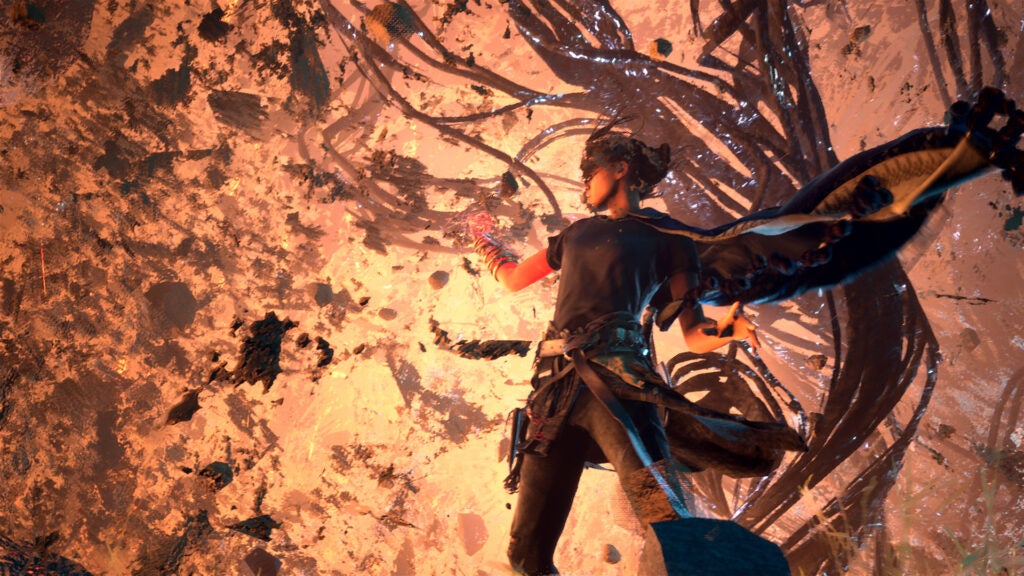
However, there are some negative points regarding the settings, like my confusion with the game difficulty. There are four difficulties to choose from, but they put some weird wording on them; they don’t sound like difficulty levels. They’re portrayed more like changes to the actual world and not changes to enemy encounters or the complexity of boss battles. The first option is “Focus on Story.” Here they describe it as enjoying the story with little emphasis on combat; so far, everything is clear here. The next option is “Explore the world.” This option explains that it is for gamers who want to explore and find new things and secrets. I assume this means the combat is a little more challenging, and any platforming puzzle is slightly more complex than “Focus on Story.” But the description implies more secrets and items can be found in this mode. So are you getting less content than the first difficulty? The next is “Challenging Battles.” The description here is literally, “For the gamer that is used to playing action games.” This is such a throwaway description. It tells me nothing except that being third on the list, it’s probably more difficult than the first two, with more “bullet sponge” boss battles resulting in more of a “challenge.” The final is “Default Mode.” It is described as balanced, whatever the metric for balanced is. I don’t know what they consider balanced, but it will be balanced, I suppose. To further confuse the user, a few screens later, you are told to choose between easy, medium, or hard. So wait, was the first option changing the gameplay? If I were to choose “Focus on Story,” would I miss gear and items deemed not necessary by the game because fights aren’t as challenging? Will I lose access to spells to simplify the game experience so that mechanics won’t get in the way? The answer I found to this is no; these are horribly explained difficulty levels.
Another issue, one that doesn’t only plague Forspoken, is a visualization of HUD settings. Listen, developers, if I change a HUD item’s color, size, or location, it is frustrating not to see an example of that change in which the slider is adjusting. I had to go into the menu and back out to see that change is asinine. Even though Luminous Productions did such an excellent job with accessibility options, allowing the player to play how they wanted, this was frustrating. Unfortunately, there are other problems I ran into. The option to have the HUD always be visible was missing. I hated having to make an attack or get into a battle before my health, items, or selected spell showed up. It is less immersive and only removes me from the game. The information I am looking for requires an unnecessary button click for me to see it, leaving me without valuable info. Most of the time, I would go into the menu, pausing my gameplay to find out where my health was or how many potions I had left. It was bothersome.
On to the mechanics. I have mixed feelings. I love the free running in the game and the unusual use of her nails as gear boosts. Frey can find different fingernail patterns that cause her to learn new power boosts. Having two hands, she can use two different sets of nails, boosting things like health, magic, auto health, and so on. I liked how the game’s spells were more simplistic and straightforward early on. The spells were single-focused on things like using a tendril to attack a group of enemies or having a plant shoot rocks at enemies. Even spells to help with attack or defense. But as the game continued and Frey was imbued with more powers from the defeated bosses, things became too complicated. There were too many spell combos to juggle, so I just stuck with basic spells. I didn’t want to think about using this spell while free running, giving me a 5% boost to my magic recharge so that I could use another spell that would allow another spell to be 10% stronger for an enemy afflicted with specific magic.
It was too much. I felt I was missing a lot of content, but it was too much of a learning curve to try and decipher, and I don’t have time to write notes on playing a game. I don’t have time to create a venn diagram of what spell overlaps another and which ones are isolated to themselves. I dislike this convoluted feel, and tossing in all the capes and necklaces you can equip was too much. Also, too many materials are available to upgrade your health or defenses given to you by the aforementioned gear. It feels like Luminous had too many mechanics they wanted to put in, causing most of them to fall short. Crafting became too cumbersome for me as there were too many options for buffs and debuffs. These could be added to the cloaks and necklaces, but I stayed with one of the first cloaks and necklaces I got. I could fully upgrade the health, defense, and magic they provided, which was enough to carry me through.

I am happy Luminous could focus on the free-running mechanic, as this is probably my favorite. Movement felt smooth most of the time, and the free-running visuals are not “Speed Lines” as you’d see in other games like Gotham Knights. There is weight, speed, and velocity to the character. When I jump through the air, I feel light until my momentum dies, and I feel like the 160-ish lbs person I am. With the cuff’s help, Frey can free-run up mountains and vault over chasms. However, the cuff’s energy is not unlimited, so when the player presses a direction and then the circle button, Frey starts her free run. It is similar to how a turbo boost works but allows you to scale buildings and mountains. However, using the boost will discharge one of the gold diamonds on the bottom left of the screen. With a limited supply, four at first, Frey cannot jump and run over things indefinitely. Most of this mechanic isn’t bothersome, but when I try to reach a treasure chest on a spire after sprinting off a cliff, it becomes annoying to realize I had used up my last boost and will have to stop and wait for it to build up again.
Since there is a lot of traversal in the world and many cliffs, one would naturally ask about fall damage. Yes, there is fall damage with a slight twist. That same power the cuff gives you to fight and run will also defend you from most damage, including falls. If you have some gold diamonds available, you can take an errant hit from an enemy, and a diamond will be used to absorb the damage, similar to Halo or Destiny’s shield mechanic. After enough damage, the cuff shield is used, and Frey will begin taking health damage. In regards to fall damage, if you fall from too high, you lose all of the cuff’s protection; you’ll have to wait for it to recharge. This means no speeding away or running up walls. But it also means if you jumped into a horde of enemies, you have no defense and will need to rely on attacking or dodging until it is charged.
As with every other modern game in existence, Forspoken has a zipline mechanic. Here it’s used to mediocre success as climbing certain mountains and buildings requires it. These items will have big rocks jutting out of them or flag poles where you can press square, and it will zip you to it, as long as it’s close enough and in frame. This zipline will also auto-connect to the corners of mountains and buildings, similar to how grapple works in Batman games. However, Forespoken doesn’t get it quite right. It feels more like Gotham Knights than the Arkham games. I have to get almost too close to the structure for it to work, but if you are too close, it won’t work. This is because you can’t look straight up. If you are standing directly below a grappled rock, Frey cannot look up straight enough to center the rock on the screen and connect a zip point. There is a manual aim if you hold down the square button, but it too is hampered by the limited degree of movement. I like that time slows down when the manual zip aim mode is activated; this helped with traversing. Overall, it was easier to free run around a short ledge than to zipline to one unless necessary.
Forspoken has some puzzle mechanics as well. Being the game is focused on free-running, there are platforming puzzles. Usually, it involves jumping from one rock to another or reaching a peak for a treasure chest. Nothing too bad, but some fine motor skills may be necessary. Speaking of treasure chests, here is a spot of contention with me. At first, I didn’t mind, but opening the locked treasure chests became annoying. Many chests in Athia are openable, but some have more valuable materials locked behind a puzzle. Not as basic as the Skyrim lockpick or as difficult as The Witness’ dot puzzles, these were somewhere in the middle. You are presented with a pipe dream-esque slide board, and if you are old like me, you may be thinking about the old Ronald McDonald picture slide puzzles at Mcdonald’s. These puzzles work very similarly. There is a sun, a moon, and multiple tiles with paths straight or in elbows. The tiles can move up, down, left, and right but cannot rotate. However, tiles in a row or column will move all at once if there is space. So you are not moving individual tiles but all tiles within a row or column by one space.

These are simple but can take time if you don’t see the pattern immediately, and this is where I started getting frustrated. I would spend one to five minutes on these chests, all for materials I found out I wouldn’t use anyway, as my gear was already upgraded by the time I went to open these. After a while, I had so much crafting materials that I maxed out my materials pouch and could not pick up some of the chest’s contents. So I would go to a chest, and it would be a 50-50 shot if I would even be able to take the contents. If not, I would have to leave it. Here comes another issue with Forspoken, inventory. I hate when games give an arbitrary inventory max. There is no encumbrance in Forspoken, but you can only carry so much of certain items. Upgrading to the materials pouch is possible, but there is a maximum number. It is unnecessary because it doesn’t do anything except force you to use or leave an item. I am already carrying 150 large crystals in my hip pouch, does being able to hold an infinite amount break my immersion into the world? No.
How about we talk about fighting? Why yes, that’s in here too! Obviously, combat is in an action-adventure game, and in this one, it’s ok. Nothing inventive, but not it’s dry. Frey has two primary forms of damage; basic magic and special magic. Early on, you’ll get the option of shooting a single rock from your hand. Tapping in succession will do a four-hit combo, ending in a charged piercing attack. I’m not a fan; I would rather have the rock shoot out for every button press. With the magic selection wheel, you are greeted with three options. One is similar to charging a large shotgun blast, one is a rock machine gun that ends with a piercing attack, and the other is a shield that will explode.
At first, it takes some getting used to because you’re using hip-fire shooting mechanics without an option to aim down sites. Decent once you get used to it, but not necessarily fun. As you progress in the game, you’ll gain different power sets related to the boss you previously defeated, which will change your element and attack type. These basic attacks can be upgraded by using them in battle. Similar to how the new God of War game does its upgrades. However, you must visit Pilgrim Houses and interact with a bookshelf to upgrade. Basically, you have to accept the quest manually. These Pilgrim houses serve as a place to rest, gain health, craft items, upgrade your character, and fast travel.
The other type of attack is special magic. Similar to the basic attacks, the special magic has a weapon wheel also and uses the right joystick to pick the ability. There are nine slots, each being a different single magic special attack. When used, that spell has to recharge. Here is where that auto spell switch I mentioned earlier comes in handy. If on, the game will switch to the next available spell once the one you’re using has to recharge. So I rarely had to bring up this wheel; the game activated the next charged spell. These spells can also be upgraded if you choose a challenge at the Pilgrim House’s bookshelf. In addition to the upgrades, you will also get different spell sets when you beat bosses, similar to the basic attacks. Overall, this basic & special magic setup is identical to a light and heavy attack system.
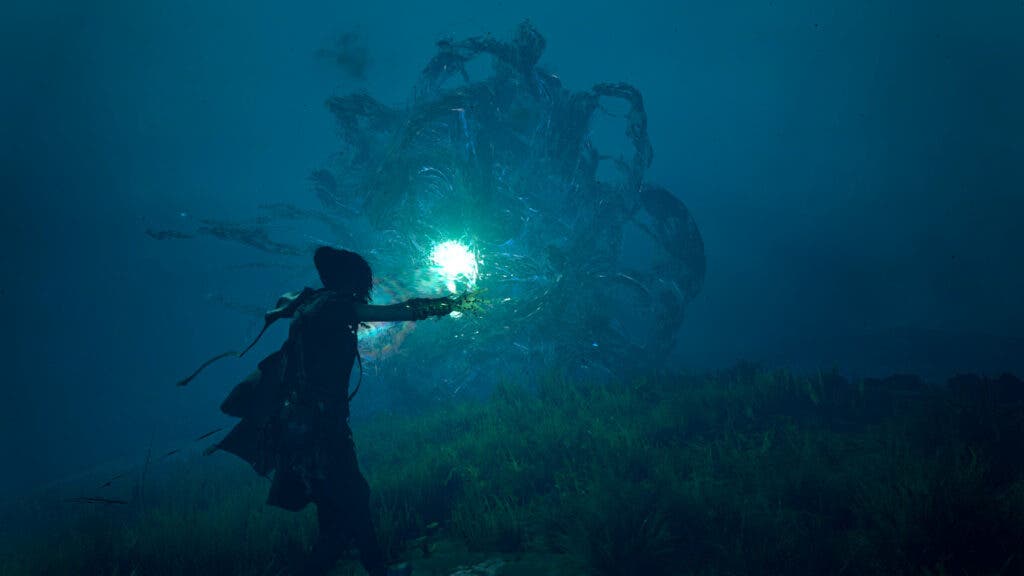
All in all, I would say I disliked this combat because it became too convoluted and involved. I often only used one or two of the basic attacks and then a special every so often. Magic combinations are just too much work, and I don’t have the capacity to think about it in the heat of the moment. Not only can your weapons upgrade, but as with any RPG game, the main character also does. Frey has an experience level that controls when certain magic is usable and what her base stats are. There is also mana that is collected in the world. This mana unlocks the special magic spells and your traversal abilities like the zipline.
We fight, great! But who are we fighting? Well, those that live in Athia. Those that lived here before the Break happened. The enemies in the game are animals and humans that have been affected by the Break; they have turned into mindless creatures of great strength. Yes, you read that right; we have another form of zombie spores! Ugh, more zombies. Sorry, I’m done with zombies as main cannon fodder in games. It has been used so often that they are no longer scary or create any suspense. They are encroaching on Goomba territory! Their inclusion is only that of XP farming at this point. However, Forspoken does include a variety of these Break enemies: Breakzombies, killer wolves, bears, deer, falcons, and other animals that are ferocious and dangerous now because of the Break. There are also these lizard-like creatures and hulking ogres.
Forspoken also has human-centric military guards that fight for the game’s main bosses, the Tantas. They, too, are affected by the Break but are so devoted to the Tantas that they fight through it to attack Frey. We also have Nightmares that live in the Break that will show up randomly. These enemies are the most challenging enemy type as they only appear within the Break storms. These Break storms also slowly drain Frey’s life, so staying and fighting in one can be deadly. Finally, there are the Tantas themselves. These are the main bosses in this land, and they are who you are tasked to kill to free the land of its plight. After defeating one of these leaders, you are imbued with their power and magical abilities.
We now come to the visuals. Let me start by saying I believe this game is as finely detailed as Horizon or God of War. Visually I feel a part of this world very much. It’s connected and tactile; even the Break storms feel like this harsh wind is blowing by. There are three graphical options to suit your needs. However, the only difference between the focus on quality, frame rate, and ray tracing is the overall frame rate. The only difference I get in quality and ray tracing is a drop to 30 frames. My TV only does 60 frames, and I believe the game can handle 120. But other than frame rates, I notice no difference to the naked eye. I’m sure digitally, a computer can spot the difference, but without that, no person can tell the difference. Let’s make looking good at 60 frames the standard, please?
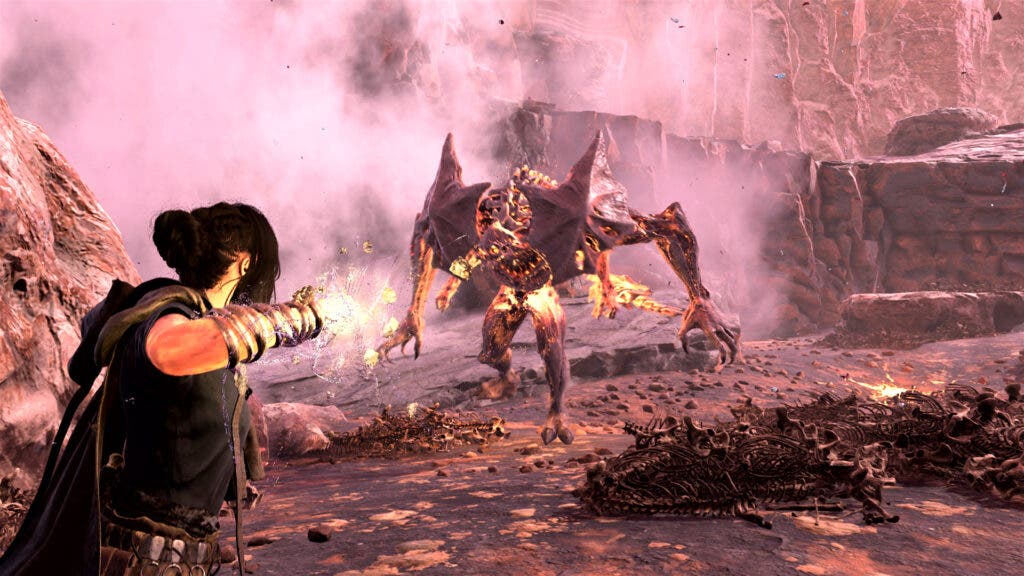
The voice acting in Forsaken could be done better. Many lines fall flat from NPCs, and dialogue from the main characters can feel phoned in. I don’t get a lot of energy from anyone in the game. The boss encounters feel grand and active, but the voices and words don’t match. Conversations between characters seem to stop, and things that should be interruptions are telegraphed and obvious. The dialogue doesn’t flow like a conversation or even a lecture. The feeling I get is that of being forced to read your paragraph out loud in class. Granted, the writing doesn’t help because it is so simplistic. Given the circumstances, it is difficult for an actor/actress to create character depth when there is none in the script. Although, there is one set of characters I don’t believe fall into this category: Frey and Cuff. You could tell the focus was on these two characters, building them up and creating depth. Granted, it isn’t great, but they are significantly better than the rest of the world they inhabit. The biggest hindrance to these characters is the writing and the story itself.
Finally, I want to speak about the map of Forspoken. I left this for last as it should be looked at and studied. The map mixes a 2D flat plane and a 3D elevation map. When zoomed out, the map is 2D, and you can move in the four cardinal directions. It shows places of interest like the Pilgrim Houses, castles, cities, and caves. It also has Belfries, which are fast travel points and functions similar to an Assassin’s Creed Sync point, a point that will open up more of the map and other icons. What is also on the map are treasure chests. This is key! All open-world games NEED to follow this method. Allow the player to turn this on. I tire of searching online for an “All chest locations in…” guide. I am more likely to explore the game if you put the collectibles on the map because I will find my own way there instead of using a YouTube video. It is so much easier and enjoyable.
As I mentioned earlier, the map can be zoomed in, and when you do this, the map becomes a full 3D representation of the world. Things like elevation and depth are shown. You can change the camera’s angle to see under and around things. This helps as instead of knowing that a treasure chest is somewhere on the mountain, you can see that it is under the cliff’s outcropping. Now I don’t have to waste time climbing to the top to climb down again. Finally, this map holds another awesome surprise. Multiple waypoint markers! I loved this in SnowRunner, and all games should have this. Forspoken has taken a step in the right direction here. You can place five separate waypoint markers that will label from 1 to 5. When trying to set a sixth, it will remove the first and place that first marker at the new location. It’s great for the collectible gamer, as I can place multiple markers and mark out my own path. The biggest help this gives is actually in game. When a marker is placed on the map, it is also placed in the world. Some would find this distracting even though they are wrong. Having these markers in world helps eliminate the mini-map requirements that people love to hate and removes the useless garbage compass from the HUD. More games should allow this option in their open-world games, allowing the gamer to play how they want and enjoy it.
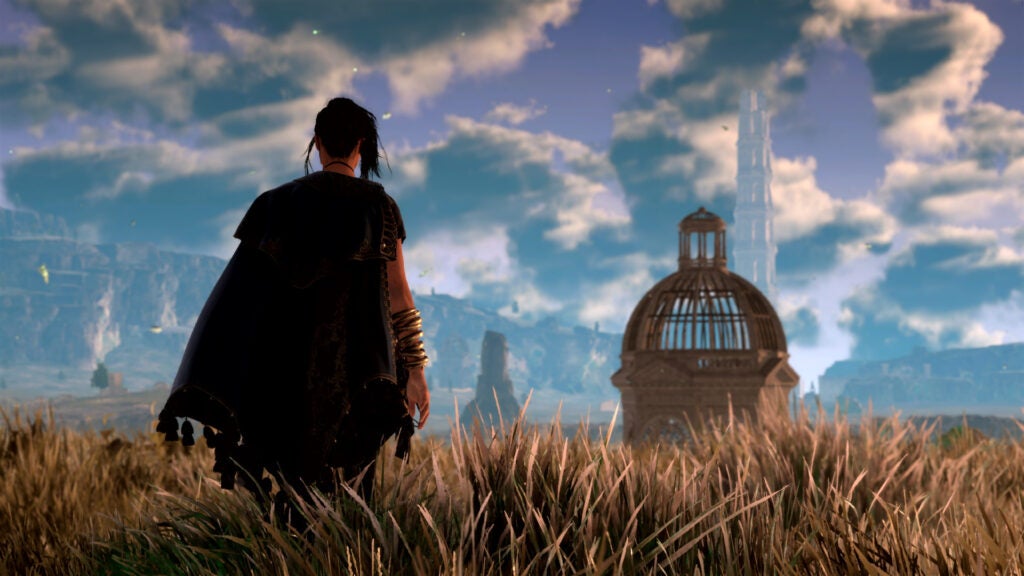
All in all, I found Forspoken to be a very well-designed game. A great many things are lacking with Forspoken, but they threw everything they could think of, including the kitchen sink, into this game, hoping something stuck. I wish Luminous Productions had taken a step back and eliminated some extra mechanics. They could have added them in a second installment once the first game was established. Honestly, I believe most of my love for Forspoken was brought on by the ability to have choices in my play style rather than the game deciding that for me. Forspoken is a game that showed me games could be fun and exciting even if there is not an engaging story to be told.
A PlayStation code was provided by the publisher for review purposes
